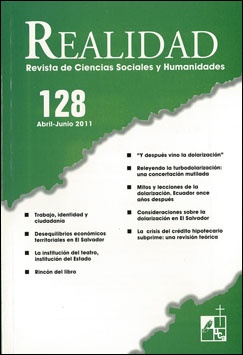Mitos y lecciones de la dolarización. El caso ecuatoriano, once años después
DOI:
https://doi.org/10.5377/realidad.v0i128.3245Keywords:
Política monetariaAbstract
La dolarización en el Ecuador fue producto de una situación económica particularmente difícil en la historia del país, la que se complementó con un entorno político favorable para que se tome una decisión de esta naturaleza. Una década y un año después de este quiebre estructural en el ámbito monetario nacional, a la vista de los acontecimientos y el afianzamiento del uso del dólar como moneda de curso legal, muchas de las expectativas, temores y percepciones que se tenían al asumirse este esquema monetario, no han correspondido con los hechos. Por eso, este documento procura aclarar algunos de estos elementos que incluso, por la forma en que siguen siendo percibidos, son en algunos casos todavía mitos, y en otros, son las lecciones aprendidas.
Realidad: Revista de Ciencias Sociales y Humanidades No.128, 2011: 195-207
Downloads
1462
Downloads
Published
How to Cite
Issue
Section
License
© Realidad: Revista de Ciencias Sociales y Humanidades
Authors who publish in this journal accept the following conditions:
Realidad: Revista de Ciencias Sociales y Humanidades, provides open and immediate access to its content, based on the Open Access Policy of the Central American University "José Simeón Cañas"provides open and immediate access to its content.
According to the copyright legislation, Revista de Ciencias Sociales y Humanidades Journal published by the Universidad Centroamericana José Simeón Cañas, recognizes and respects the moral rights of the authors, as well as the ownership of the patrimonial right, which will be assigned to the journal for its diffusion in open access, in printed version and in digital format. By being part of multiple indexers, databases and reference systems, the articles published by Revista de Ciencias Sociales y Humanidades will be visible and available for downloading on these websites, indicating, in all cases, the authorship of the articles, the date of publication and the number of the journal to which they correspond.
You are free to:
- Share: copy and redistribute the material in any medium or format
- Adapt: remix, transform, and build upon the material
Under the following terms:
- Attribution: You must give appropriate credit, provide a link to the license, and indicate if changes were made. You may do so in any reasonable manner, but not in any way that suggests the licensor endorses you or your use.
- Non-Commercial: You may not use the material for commercial purposes.




